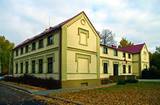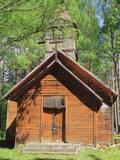| Nr | Name | Beschreibung |
|---|---|---|
|
In 1888, the building, provided for a doctor’s needs, was donated by Baron Alexander Alexei von Pistohlkors to the parish of Pēterupe Lutheran Church. Along with the building, Baron Pistohlkors also donated 6 hectares of land and 10 000 roubles for the doctor’s use. Arvēds von Engelhards became the first medical doctor in Pēterupe. In 1890, the first pharmacy was opened in one room of the clinic, serving people from a wide area; it remained in the building until 1895. This outpatient clinic was the very first stone building in Saulkrasti, the first health authority in a wide area, as well as the first pharmacy. Through its entire lifetime, the house was maintained from voluntary donations – at first by Alexander Alexei von Pistohlkors, then by churchgoers of Pēterupe Parish – therefore by the money of the villagers. |
||
|
Die Kräuterfarm Ööbiku, die sich in einer ökologisch reinen Gegend befindet, befasst sich mit dem biologischen Anbau von Kräutern, Beeren und Gemüse sowie deren Weiterverarbeitung. Hier werden auch Wurzelgemüse, Obst und Beeren getrocknet. |
||
|
Atrodas skaistā vietā – pašā Daugavas krastā. Ēdina, klāj galdus, piedāvā braucienus ar kuģīti pa Daugavu. |
||
|
Der weiteste Nordpunkt der Juminda Halbinsel mit einer Raketen-Attrappe der Sowjetarmee, der alten Grabstätten, dem Juminda-Leuchtturm und einem Denkmal für die Opfern des Zweiten Weltkriegs. |
||
|
Eine Asstellung der Steine unter freiem Himmel, eingerichtet vom litauischen Ärzt Intas Vaclovas (1925 – 2007). Ein Museum der einzigartigen Steine. |
||
|
Viens no jaunākajiem Latvijā celtajiem mūra tiltiem. Tā akmens margas ir barona Karla fon Manteifeļa dāvinājums (celts 1907. gadā) Aizputei. Tilta ziemeļu puses margās ir iemūrēta granīta plāksne ar Manteifeļu dzimtas ģerboni, kas ir vāji izšķirams. |
||
|
Dievnama mūri kā svētvieta glabā ne tikai svētuma starojumu, mierinājumu, bet arī smagus, rūgtus un iznīcinošus notikumus. Vairākkārt pārbūvēta, sagrauta, dedzināta, un tomēr atjaunota. |
||
|
Der Nationalpark Ķemeri (1997 gegründet) ist hauptsächlich zum Schutz von Feuchtgebieten – der seichten Küste der Rigaer Bucht, der zugewachsenen Küstenseen, Moore, der feuchten Wälder (Sümpfe u.a.) und Hochflutbetten eingerichtet worden, die für viele Pflanzen (~25 % von den Arten, die auf der roten Liste Lettlands stehen), Tiere und besonders als Wohnorte für nistende Vögel und Zugvögel bedeutend sind. Auf dem Gelände des Parks befindet sich einer der größten Moore in Lettland – der große Moor von Ķemeri. Die großen Moore sind bedeutend für die Bildung vom schwefelhaltigen Mineralwasser und als Quelle dieses Wassers, sowie als der Ort, wo man Schlamm findet, den man medizinisch als Heilmittel verwendet und der als Grundlage für die Bildung des früher sehr bekannten Kurortes Ķemeri war. Im Park werden die Besucher von Erkundungspfaden, Rad- und Wanderrouten und Vogelbeobachtungstürmen angezogen. Route information from Latvijas Lauku forums |
||
|
In dem Backprozess des Brotes von Lāči, das nicht nur in Lettland, sondern auch über die Grenze berühmt ist, werden seit langer Zeit gepflegte Meisterkenntnisse und Meisterfertigkeiten angewendet. Hier kann man Führungen bestellen, einen Brotlaib formen und backen, eine Mahlzeit in einem netten Wirtshaus zu sich nehmen und Produkte kaufen. Das aus Roggenmehl gebackene Brot ist eines der Identitätssymbole Lettlands. Lettische Küche: Cremige Steinpilzsuppe, verschiedene heiße Töpfe, Brotsuppe, Dessert des Bäckers. |
||
|
Einer der größten Hersteller der Produkte der Ziegenzucht in Lettland. Es werden ~ 160 rassereine Ziegen (Alpenziegen, Anglo Nubier Ziege, Weiße Deutsche Edelziege) und Hauseber (für die Zuchtarbeit) gezüchtet. Exkursion und Teilnahme an die Ziegen-Beweidung. Von März an kann man die Ziegenkitze anschauen. Verkostung von verschiedenen Käsespezialitäten, Schaumelken (ab 17:00). Verkostung und Erwerb von Fleischkonserven. Produkte ohne Konservierungsstoffe! |
||
|
Harilaidas galā no jūras ūdens paceļas 26 m augstā Kīpsāres bāka – viena no neparastākajām Igaunijas bākām. Tā celta 1933. g., kad jūra no bākas atradās ~ 100 m attālumā. Krastu noskalošanas rezultātā tā tagad ir viļņu ieskauta. |
||
|
Der Apakšceļš (der untere Weg) - ein einsamer Weg, der durch die Wälder und
Moore zwischen Košrags und Dūmelis verläuft, mit dem viele interessante Fakten
zusammenhängen: die Mühle von Pitrags, die niemals in Betrieb genommen
wurde (es sind noch Reste von der Aufschüttung zu sehen); der Dampfkessel von
einem verunglückten Schiff, den der örtliche Baron zum Teerbrennen benutzt hat;
die ehemalige Pferdestraße, die durch das Bažu Moor verlief und der markante
Stein von Dūmele.
|
||
|
In dem Haus Riekstiņi in Nereta hat der bekannte lettische Schriftsteller und Maler Jānis Jaunsudrabiņš (1877 - 1962) sechs Jahre seiner Kindheit verbracht. Jānis Jaunsudrabiņš wurde in einer Dienerfamilie in dem Haus Krodziņi geboren, aber in das Haus Riekstiņi ist er mit seiner Mutter nach dem Tod seines Vaters umgezogen. Die in dem Haus Riekstiņi wohnenden Menschen wurden zu Prototypen in seinem Buch Das weiße Buch (Baltā grāmata), wo dieses Haus das unsere Haus genannt wird. Zu Ehren von Jānis Jaunsudrabiņš wurde im Jahr 1967 in dem Haus Riekstiņi ein Museum eingerichtet, das sich auf einem authentischen Einzelgehöft der Region Sēlija befindet, das seinen eigenen Geist und eigenen Duft hat. Hier kann man das Wohnhaus, eine Kornkammer und einen Wagenschuppen besichtigen. Das Haus Riekstiņi ist ein Muss bei der Besichtigung der historischen Region Sēlija. Auf dem unweit gelegenen Friedhof von Ķiški (an der Straße Vecumnieki – Ilūkste) ist Jānis Jaunsudrabiņš umbestattet und die Angehörigen seiner Familie bestattet worden. |
||
|
This is a site where you can try out ancient weapons – bows and crossbows (a reproduction of items from the 14th and 15th century), throwing an axe (replicas of German axes from the 13th century), and spears. Once you’ve learned how to handle those weapons, you can also forge a copy of a Medieval coin. You can try on copies of armoured caps and gloves and have your picture taken with a sword or battle axe. For larger groups, the enterprise will organise ancient sports and table games.
|
||
|
Krupenišku Old-Believer Prayer House was built in 1908. The autor of the
design is engineer I. Ivanov. At present the church is in bad tehnical condition.
|
||
|
Auf dem Urbo-Hügel befindet sich der 1953 ronovierte schönste Leuchtturm an der Küste Litauens. Das Licht von diesem Leuchtturm kann man in einer Entfernung von 22 Seemeilen sehen. |
||
|
Ap 1,6 km garā un labiekārtotā Adamovas dabas taka iepazīstina ar Adamovas krauju un tās apkaimē esošajām dabas vērtībām. Takas sākums meklējams pie autostāvlaukuma, no kura paveras plašs skats uz Krāslavu un Daugavas senieleju. Adamovas krauja (aizsargājams ģeoloģisks piemineklis) ir viena no garākajām (ap 1,7 km) un augstākajām (25 - 35 m) Daugavas kraujām. Tā veidojusies sānu erozijas rezultātā, Daugavas ūdeņiem noskalojot Daugavas pamatkrastu Adamovas loka ziemeļdaļā. |
||
|
Ein einzigartiges Territorium in Lettland, großflächige Laubwälder mit Eichen (viele Ureichen), Linden und Eschen. Führungen mit lokalen Führern und Förstern. Naturschutzgebiet.
|
||
|
Der Bau der Valmiera–Burg wurde 1283 angefangen. Im Laufe des Nordkrieges (1702) wurde die Burg verbrennt, aber am Ende des 17. Jh. wurden die Außenmauern der Stadt abgebaut. Es sind die Ruinen der Burg und die Reste der anderen mittelalterlichen Befestigungsanlagen erhalten. |
||
|
Die Dünen nördlich Pervalka über dem ehemaligen Dorf Negeln. Eine 9 km lange Strecke mit den wüstenartigen Landschaften. Stegpfade. |
||


















